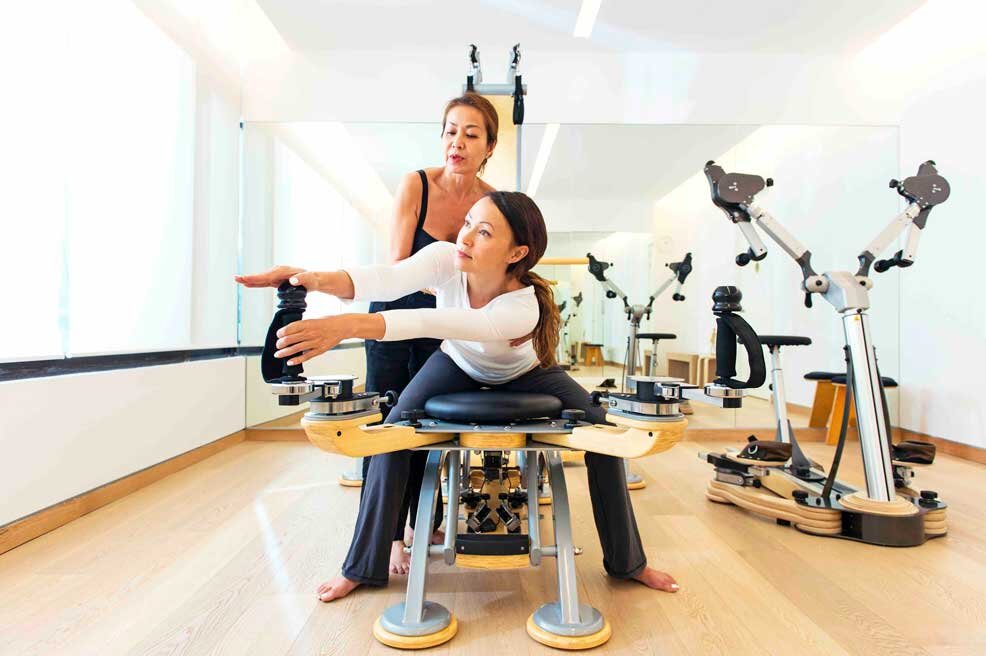Why your fitness routine should include Pilates (for posture and injury prevention)
Offering a full-body workout, Pilates skips the ohm-ing and gets straight to the toning and improves posture. Oh, and it’s low impact
Text: Tiff H
Pilates is often seen as yoga’s less trendy, less zen sibling, yet it has endless benefits for both the mind and the body. Like yoga, Pilates focuses on breathing techniques, mental focus, flexibility, strength and control, and offers a low impact but effective full-body toning workout. The main difference between the two is the importance of spirituality in the yoga practice, whereas Pilates is very much agnostic and has been proven to help improve posture as well as injury prevention.
To understand more about what sets Pilates apart from other low impact workouts, and to find out why we’d be wise to slot Pilates into our existing fitness routine, we spoke to Fhe, Senior Pilates Trainer at COMO Shambhala Singapore. A true veteran of the industry, Fhe has an array of multi-disciplinary fitness and movement certifications, including being certified in STOTT Pilates at Pilates International Academy (PAI) in New York.
Credit: COMO Shambhala - Pilates
What exactly is Pilates?
Pilates is an exercise system that actively engages the mind and body to achieve physical fitness in an exercise regime. It focuses on the deep stabilising muscles of the torso, hips, and shoulder girdle and helps develop long, lean, functionally strong muscles without bulk. These deep muscles help change and improve your posture and enable you to move with ease and feel more energetic. When practiced regularly, Pilates can transform your body, improve your posture and give you a full body workout.
Who is it good for?
The Pilates method can be for anybody, whether you’re very active, an athlete, elderly, pre- and post-natal, suffer from osteoporosis or postural imbalance. It’s particularly good for those who require help with posture and injury prevention because the exercises are tailored to cater to an individual’s specific needs or goals. It’s a mind-body exercise technique that uniformly develop the body, helps calms the mind and reduces stress. It develops strength, flexibility and control; and it’s accessible to just about everyone.
Credit: COMO Shambhala - Pilates
What are the top benefits of Pilates?
The benefits are endless. Here’s an overview:
Enhance quality of Life
Build core strength
Strength and flexibility
Reduced injury risk
Better posture
Improve body awareness
Coordination and balance
Efficient and flowing movement
Reduced injury risk
Sense of wellbeing
Increased mental fitness
What are the common misconceptions about Pilates?
People who have never done or are new to Pilates practice tend to ask a lot of questions and make a lot of assumptions. Some exhibit confusion, thinking that Pilates is like yoga, likely because some Pilates movements are based on observation of the natural movements of wild animals, or just focused on stretching. Others assume that it’s only for women or is too easy, while others think that they’re not fit enough orthat it requires equipment.
Credit: COMO Shambhala - Pilates
How does Pilates help with Injury prevention?
Integration is one of the important movement principles in Pilates that helps prevent injury in our daily life. It provides you with the ability to see your body as a whole, and creates awareness on how you distribute your weight to give you an upright posture. When your head, torso and pelvis are aligned, it’s easier to stand tall or to sit upright with no pressure on your lower back, neck or joints.
Additionally, Pilates lengthens and strengthens your muscles, firming up your core. This workout is ideal for both rehabilitation from past injuries, as well as strengthening to prevent future injuries, as it improves muscles, joint flexibility, increases balance, reduces discomfort, and assists with alignment.
Is Pilates safe for rehabilitation?
It depends on where the individual is on their rehabilitation journey. They should not be experiencing any acute pain, numbness or tingling when performing a movement pattern or working out. They should also be referred by a doctor or physiotherapist.
If the individual is at the right stage, Pilates is safe for rehabilitation as the knowledge of a trained Pilates rehab trainer will help the individual re-establish and improve his/her kinetic awareness and overall movement and functional skills.
Pilates is a low impact workout and because it can be adapted to accommodate almost any injury, it’s safe for those who want to stay active during the rehabilitation process. It also helps clear the mind of any negative thoughts and feelings, which many believe can be the difference between a full recovery or not recovering completely.
Credit: COMO Shambhala - Pilates
How does it improve your posture?
Many of us slouch more than we should to maintain a healthy spine. There are several negative effects that this can have on our bodies; bad posture can lead to stress, increased depression, decreased circulation, digestion issues, pinched nerves and can even cause issues in your job and daily lifestyle.
Pilates exercises focus on finding the muscles of your powerhouse (core) and strengthen this area to support your spine. If you’re consistent in taking practice, you will reap the benefits of better posture, a strong centre, suppleness, a toned body and an improved sense of well-being — not to mention how invigorated you will feel after working out.
If you are interested in finding out more about COMO Shambhala Singapore or reserving a slot, calling their wellness concierge at +65 6304 3552.















